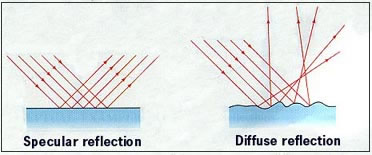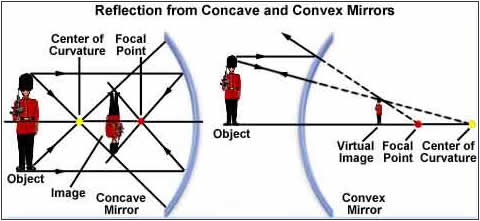
You are here: Home >> Encyclopedia of Light >> Reflection
 Using simple words reflection is the phenomenon when light is returned after impinging on a surface. To accept reflection we must accept the wave nature of light, because reflection has to do with waves. Part of light wave or whole the wave remains at the same medium after the reflection.
Using simple words reflection is the phenomenon when light is returned after impinging on a surface. To accept reflection we must accept the wave nature of light, because reflection has to do with waves. Part of light wave or whole the wave remains at the same medium after the reflection.
During reflexion the angle between the direction of motion of the oncoming wave and the perpendicular to the reflecting surface (angle of incidence) is equal to the angle between the direction of motion of the reflected wave and a perpendicular (angle of reflection).
When light meets with a mirror is reflected and what follows is the representation of our image onto the mirror. What we just described is not the usual situation, because a mirror is considered to be a perfect surface without convolutions.
 Most of the times light does not meet with such perfects surfaces. An orange orange for example has a surface -definately not perfect- which reflects the orange component of "white" light (the "white" light includes all the components of colors), whereas it absorbs all the other components, the red one, the green one etc.This makes possible the vision. Now we can say we are talking about specular reflection and the similar phenomenon of diffuse reflection. Although someone has a certain idea about reflection in his mind, he does not realize the fact that diffuse reflection is much more critical.
Most of the times light does not meet with such perfects surfaces. An orange orange for example has a surface -definately not perfect- which reflects the orange component of "white" light (the "white" light includes all the components of colors), whereas it absorbs all the other components, the red one, the green one etc.This makes possible the vision. Now we can say we are talking about specular reflection and the similar phenomenon of diffuse reflection. Although someone has a certain idea about reflection in his mind, he does not realize the fact that diffuse reflection is much more critical.
Another part which has to do with reflection is the phenomenon when light meets surfaces which can reflect it but they are not flat. The surface of a spoon is the perfect example we all learnt during school years.  The surface of a spoon is not a mirror but at the same time it is something similar to it.
The surface of a spoon is not a mirror but at the same time it is something similar to it.
We generaly use two terms to describe such non flat mirrors: The concave mirror which could be represented by the inner surface of a spoon and the convex mirror which could be the outer surface. In both phenomena the reflected image appears misshapen. Concave mirrors are widely used in light telescopes where the light that reaches the telescope is not enough to represent an image. The concave mirror concentrates the rays to a single point, thus we achieve the representation. On the other hand, we take advantage of convex mirrors in motorways where a convex mirror offers a wider field of vision than a usual mirror. The mixture of concave and convex mirrors are usual at fun fairs where one could be scared of his appearence tottaly misshapen.
Reflection plays an important role to modern microscopes. Light is succesivily reflected from mirrors and at the same time it is magnified. Finally we are able to take a satisfactory magnification of the element we examine.